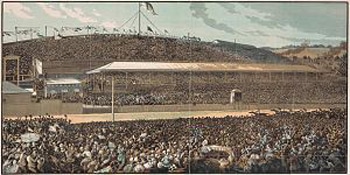The Melbourne Cup is Australia’s major thoroughbred horse race. It is a race for three-year-olds and over and is the richest “two-mile” handicap in the world.
Horse Talk – handicap: A handicap race in horse racing is a race in which horses carry different weights, assigned to them by the handicapper or racing secretary. A better horse will carry a heavier weight, to give him or her a disadvantage when racing against slower horses. The handicapper’s goal in assigning handicap weights is to enable all the horses to finish together in a dead heat.
In theory, 2.2kg of extra weight results in slowing a horse down by 1 length. So, if one horse carries 54.2kg and another horse in the same race carries 52kg (a difference of 2.2kg), then the horse carrying the heavier weight is giving 1 length to the other horse.
1. How many lengths advantage will a horse carrying 52kg have over a horse carrying 63kg?
2. The highest-weighted winner of the Melbourne Cup was Carbine who carried 65.5kg to win in 1890. The winner of this year’s race, Fiorente, carried 55kg. Had these two horses run in the same race, how many lengths would Carbine be giving Fiorente? Round your answer to the nearest tenths.
The event is scheduled to start at the same time each year, 3pm on the first Tuesday in November.
3. What day of the week was the race run this year?
The Melbourne Cup is run over a distance of 2 miles.
1/8 of a mile = 1 furlong or 200m
4. Express the race distance in furlongs.
5. Express the race distance in meters.

6. What is this kind of graph called?
7. What would you label the vertical axis?
8. What would be a good title for this graph?
9. How many 7-year-old horses have won the Melbourne Cup?
10. How many 6-year-old horses have won?
11. Which age categories have the greatest number of winners?
The present record holder is the 1990 winner Kingston Rule with a time of 3min 16.3sec. This year, Fiorente finished with a time of 3min 20.3seconds.
12. How much faster was Kingston Rule than Fiorente?
Would you like to watch this year’s race?
Richest “Two-Mile” Handicap in the World – Answers
1. How many lengths advantage will a horse carrying 52kg have over a horse carrying 63kg?
Answer:
Step 1: 63 – 52 = 11.
Step 2: 11 ÷ 2.2 = 5. The horse carrying 54kg will have a 5 length advantage.
2. The highest-weighted winner was Carbine who carried 65.5kg to win in 1890. The winner of this year’s race, Fiorente, carried 55kg. Had these two horses run in the same race, how many lengths would Carbine be giving Fiorente? Round your answer to the nearest tenths.
Answer:
Step 1: 65.5 – 55 = 10.5.
Step 2: 10.5 ÷ 2.2 = 4.77. Carbine would have been giving 5 lengths to Fiorente.
3. What day of the week was the race run this year?
Answer: Tuesday
4. Express the race distance in furlongs.
Answer: Step 1: It takes 8, ‘1/8’ of a mile sections to add up to 1 mile. Therefore, the number of ‘1/8’ of a mile sections in two miles is 2 x 8 = 16. There are 16, ‘1/8’ of a mile sections in 2 miles.
Step 2: Given that 1/8 of a mile = 1 furlong, there are 16 furlongs in 2 miles. The Melbourne Cup is run over 16 furlongs.
5. Express the race distance in meters.
Answer: 16 x 200 = 3200. The Melbourne Cup is run over 3200 meters.
6. What is this kind of graph called?
Answer: Horizontal bar graph.
7. What would you label the vertical axis?
Answer: Age of Winners
8. What would be a good title for this graph?
Answer: Age of Winners of the Melbourne Cup or Winners by Age of the Melbourne Cup. Did you come up with a different one? Why not leave a comment and share your graph title with other HLM members!
9. How many 7-year-old horses have won the Melbourne Cup?
Answer: Ten horses have won the Melbourne Cup.
10. How many 6-year-old horses have won?
Answer: Thirty-one horses have won the Melbourne Cup.
11. Which age categories have the greatest number of winners?
Answer: Two categories are tied for the most winners, ages 4 and 5.
12. How much faster was Kingston Rule that Fiorente?
Answer: 3 min 20.3 seconds – 3 min 16.3 seconds = 4 seconds. Kingston Rule was faster by 4 seconds!
Photos:
Fiorente winning Melbourne Cup
Engraving of the finish line at the 1881 Melbourne Cup








